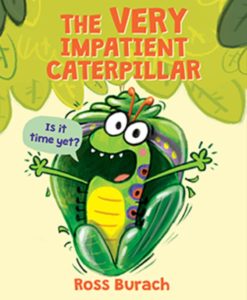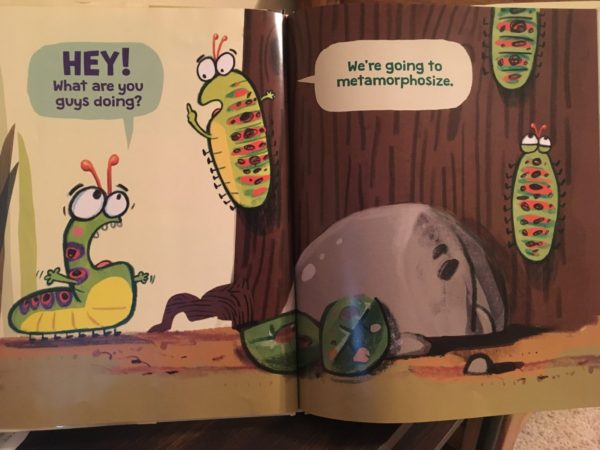Why I Picked It Up: The Very Impatient Caterpillar called to me from the new picture bookshelf at our library today! The illustration of the caterpillar in the cocoon on the front (clearly not a butterfly yet) along with the word “impatient” in the title had me curious about what kind of story this might be!
Why I Finished It: I really felt like I could identify with this caterpillar. There’s always one that doesn’t quite fall into line perfectly! Our main character in The Very Impatient Caterpillar is a few steps behind in the beginning, causally questioning fellow caterpillars about what they are doing, and then once he catches up and builds his own chrysalis, he isn’t very good at sitting around and waiting. I loved how he emerges from his chrysalis prematurely and realizes that there really isn’t anything he can do and then has to try again, letting nature take its course.
As I was reading out loud, I kept thinking of Mo Willem’s pigeon. He and the caterpillar would probably get along very well – they are both loud, inquisitive and slightly clueless characters that seem to be prone to intense emotions. There were even several pages in The Very Impatient Caterpillar that reminded me of the part in the pigeon stories where Pigeon displays a wide range of emotions and may or may not experience a change of heart.
I enjoyed the dialogue, the bright illustrations caught (and kept) my kids’ attention, and we all learned some science too – it was a win-win!
Who I’d Give It To: This is a great read aloud! Elementary teachers can use it in both science and reading, and parents who have kids that constantly ask “are we there yet?” will enjoy sharing this story with their kiddos as well.
Integration Ideas
Theme
Patience
- How does impatience manifest itself?
- What factors affect a person’s patience?
- Is having patience always positive?
On top of having students contemplate the guiding question above, have students discuss and research the old saying, ‘Patience is a virtue’. Depending on the age of the students, they can look up the definition of patience, research how the saying originated and carried on, analyze what they think about the saying, create a graphic for the saying, etc.
Transformation/Change
- How does the environment, or changes in the environment, impact a person’s character?
There’s a clever duality in the themes of this book! The caterpillar physically transforms into a butterfly, but he also transforms emotionally as he discovers, first-hand, the virtue of patience (well, mostly!).
Science – Life Cycle of a Butterfly
We’ve all seen the diagram of the life cycle of a butterfly, but The Very Impatient Caterpillar brings that static (*ahem* boring!) diagram to life! The vocabulary associated with the process is successfully incorporated into the dialogue, and the two big ones – metamorphosis and chrysalis – are introduced right up front in the first few pages. If you didn’t have any clue what those words meant, they are defined by context clues, either in the text or the illustrations, that will give you enough understanding to make it through the rest of the story. But if science is your focus, particularly in the older elementary grades that might think they are too old for Eric Carle’s The Very Hungry Caterpillar, this is a great book to start the conversation about life cycles. You can easily come back to study the first few pages after you’ve read the story once through for enjoyment!
For example, on the first page, you can ask students to study the picture and then have a conversation. What do you think “metamorphosize” means, based on what you see? Why are the caterpillars all going up the tree? What kind of tree do you think this is? Where in the world do you think this scene takes place? What time of year is it? What do you notice about the leaves on the ground by the tree? Why would the leaves have holes in them?
You can have a similar conversation when the caterpillar builds the chrysalis, when the caterpillar finally decides to be patient and you see the two weeks laid out on the page, and at the end when the other butterflies are talking about migrating.
Multiple Perspectives/Creative Writing/Science *Fustions*
Metamorphosis is definitely a natural process, but we only observe it from the outside, where it looks like nothing happens until the last day when the butterfly emerges. In The Very Impatient Caterpillar, we get to see inside the chrysalis! Granted, this is a fictional story about an anthropomorphized caterpillar, but it’s a great exercise in putting yourself in someone else’s shoes. We want students to learn to see things from multiple perspectives in order to develop a deeper, more meaningful understanding of the world around them. This is particularly helpful in social studies, as they study other countries and people groups that aren’t just like them. Seeing someone else’s side of the story can help in social situations both in school and at home, and can help students develop compassion and empathy, which will lead to better connections and understanding of fiction.
You can turn this into a writing assignment. This caterpillar knows the outcome – he will become a butterfly…eventually. Why is he so impatient? How would you feel if you had to wait for two weeks for something exciting to happen? How would you feel if you were confined to a small space while you waited? What if you didn’t know what would happen? Would that make it easier or harder to wait?
Or, pick another animal with an interesting life cycle (like a frog) or another natural process (like the water cycle, the seasons, plant growth) and have students add human emotions, putting themselves in the place of the protagonist in their chosen situation. If they need to research the scientific concept a bit, allow time for that, but encourage students to make it more of a story than a report!
Share with us how you will use this mentor text.









Leave a Reply